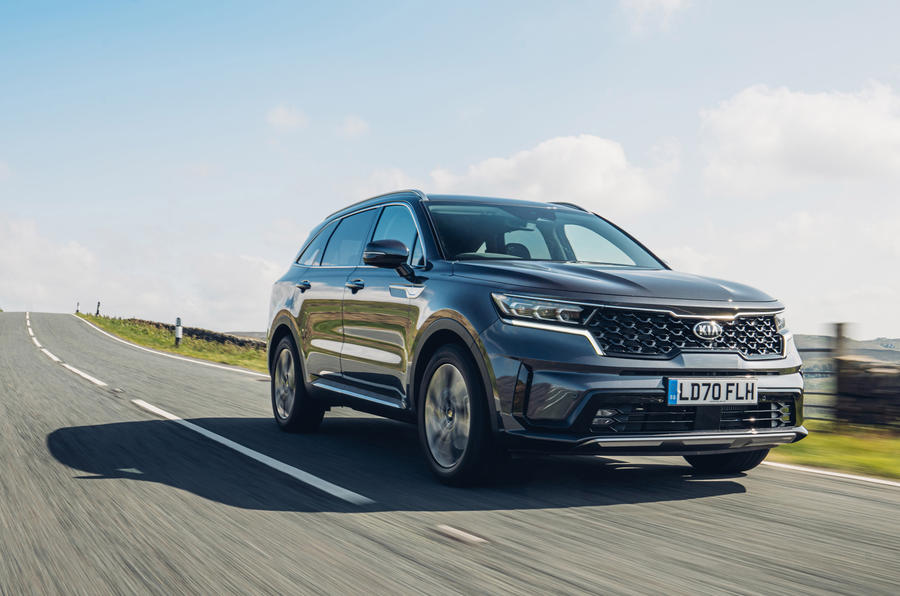What is it?
It’s no surprise that the new Kia Sorento has been launched as a trendy petrol-electric hybrid, nor that it will soon become available as a Sorento plug-in hybrid too. What might raise an eyebrow, though, is that the diesel option has survived into the model’s fourth generation.
Sales of diesels won't stop plummeting, not just due to the bad taste left in the public’s mouth from the Volkswagen scandal but also because company car tax rules now make hybrids, particularly PHEVs, the obvious choice. However, if diesel survives anywhere, surely it will be in repmobiles, for long-distance economy, and large SUVs, favoured as they are by those who tow caravans, horseboxes and suchlike.
And the new Sorento is certainly a large SUV, being even longer and wider than its predecessor, at 4810mm and 1900mm. Thankfully, that extra metal is compensated for by a new, lighter engine 2.2-litre four-cylinder diesel engine, which produces 199bhp and a healthy 325lb ft of torque. Both the hybrid and PHEV, meanwhile, make just 258lb ft.
That extra torque you trade for CO2 emissions, with the diesel falling into the top benefit-in-kind tax band of 37%. The PHEV’s WLTP figures have yet to be confirmed, but we know how ridiculous these usually are. For instance, you pay just 10% for the P300e plug-in hybrid version of the Land Rover Discovery Sport – which is probably the Sorento’s biggest rival.
Like the Korean car, it’s a large, luxurious, seven-seater that costs from around £40,000 and offers both hybrid and diesel power. If you still think of the 2002 original when picturing the Sorento – a gawky, body-on-frame 4x4 – you couldn’t be further from the truth. The Kia badge is steadily gaining prestige and respect, and products like this show exactly why.
Even compared with that of the old Sorento, the interior is serious business. The materials in all the key places feel of high quality, touches such as a stylish light motif on the front doors make it feel special and the seats are comfortable – but it’s probably the technology that impresses the most.
In front of you is a clear, configurable 12.3in digital instrument display, and in the centre of the massive dashboard is a 10.25 touchscreen. It will take a while to get used to, but the functionality is thereafter simple and comprehensive; it certainly doesn’t feel like it has been just lifted out of a Ceed or something, and it never once lagged or crashed during our test.
Also, while we would normally dismiss the ‘ambient soundscape’ options as a gimmick, sitting in a big, warm leather chair with your eyes closed and having the car fool you into thinking you’re in a coffee shop or summer forest suddenly sounds very appealing as we enter a winter lockdown.





































Join the debate
Add your comment
You've got to consider
You've got to consider depreciation in this. A Discovery Sport will save you mega bucks in that respect.
I like it but.....
...it's as ridiculously priced as all the other inflation-busting over-priced money pits out there now.
It wasn't that long ago that this car would've cost almost half as much as it does now - the 2010 model Kia Sorento 2.2 CRDi started from £22,180!
Size fetish
The author of this article is clearly unaccustomed to driving anything larger than a Fiesta, judging by his constant references to the Sorento's allegedly 'large' proportions. As the worldy-wise will know, the Kia is just another mid-size family SUV. And his bizarre claim that it's particularly suited to Texas - where the full-size Tahoe, Suburban, Expedition and Yukon reign supreme - further demonstrates the limitations of his knowledge.
Sadly Mr Culmer's ignorance extends to British products too, as the Disco Sport ain't a large SUV either. In fact it's less than 4.6m in length, which is considerably shorter than medium-size saloons such as Mondeo, Insignia, Passat etc.
Am I alone in wondering if the British motoring press is actively collaborating with auto makers to persuade consumers to pay big car money for ordinary motors?